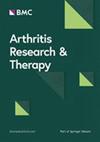Identification of serum exosome proteins in systemic sclerosis with interstitial lung disease by aptamer proteomics
IF 4.6
2区 医学
Q1 Medicine
引用次数: 0
Abstract
A major unmet need for Systemic Sclerosis (SSc) clinical management is the absence of well validated biomarkers for early diagnosis of SSc-associated interstitial lung disease (SSc-ILD). The objective of this study was to identify proteins contained within serum exosomes that may serve as potential biomarkers to differentiate patients with Diffuse SSc without SSc-ILD from patients with Diffuse SSc with SSc-ILD employing aptamer-based proteomics. Serum exosomes were isolated from two cohorts of patients. The first cohort included 15 patients with Diffuse SSc without SSc-ILD and 14 patients with Diffuse SSc with SSc-ILD and the second cohort included 12 patients with Diffuse SSc with SSc-ILD and 12 patients with Diffuse SSc without SSc-ILD. SOMAscan aptamer proteomics was performed with the first cohort and quantified the concentration levels of 1,305 proteins. Significant associations of differentially elevated or reduced proteins (p < 0.05 |FC|>1.2) discriminating between the two SSc clinical subsets were assessed. Validation of the results obtained from the proteomics analysis of the first cohort was performed with the second cohort. The aptamer proteomic analysis identified 29 proteins increased and 9 proteins decreased in SSc with SSc-ILD as compared to SSc without SSc-ILD. Principal component analysis using the 20 most significantly differentially expressed proteins resulted in excellent separation of the two SSc clinical subsets. Most of the differentially increased proteins converged around enhanced inflammatory responses, immune cell activation, cell death, and abnormal vascular functions and several of them displayed a highly significant correlation with the CO Diffusion Capacity Levels. Aptamer proteomic analysis of circulating exosomes from patients with Diffuse SSc with and without SSc-ILD identified several biologically plausible biomarkers that may be of value to differentiate these two SSc clinical subsets.适体蛋白质组学鉴定系统性硬化症合并间质性肺病血清外泌体蛋白
系统性硬化症(SSc)临床管理的主要未满足需求是缺乏经过良好验证的早期诊断SSc相关间质性肺疾病(SSc- ild)的生物标志物。本研究的目的是鉴定血清外泌体中含有的蛋白质,这些蛋白质可能作为潜在的生物标志物,用于区分无SSc- ild的弥漫性SSc患者和有SSc- ild的弥漫性SSc患者。从两组患者中分离出血清外泌体。第一组包括15例无SSc- ild的弥漫性SSc和14例伴SSc- ild的弥漫性SSc,第二组包括12例伴SSc- ild的弥漫性SSc和12例伴SSc- ild的弥漫性SSc。对第一个队列进行SOMAscan适体蛋白质组学,量化1305个蛋白质的浓度水平。评估两种SSc临床亚群之间差异升高或降低蛋白的显著相关性(p 1.2)。用第二组对第一组的蛋白质组学分析结果进行验证。适体蛋白质组学分析发现,与没有SSc- ild的SSc相比,SSc- ild的SSc中有29个蛋白增加,9个蛋白减少。使用20个最显著差异表达蛋白的主成分分析导致两个SSc临床亚群的良好分离。大多数差异增加的蛋白集中在炎症反应增强、免疫细胞活化、细胞死亡和血管功能异常周围,其中一些与CO扩散能力水平高度相关。对伴或不伴SSc- ild的弥漫性SSc患者循环外泌体的适体蛋白质组学分析发现了几个生物学上合理的生物标志物,这些生物标志物可能对区分这两种SSc临床亚群有价值。
本文章由计算机程序翻译,如有差异,请以英文原文为准。
求助全文
约1分钟内获得全文
求助全文
来源期刊

Arthritis Research & Therapy
RHEUMATOLOGY-
CiteScore
8.60
自引率
2.00%
发文量
261
审稿时长
14 weeks
期刊介绍:
Established in 1999, Arthritis Research and Therapy is an international, open access, peer-reviewed journal, publishing original articles in the area of musculoskeletal research and therapy as well as, reviews, commentaries and reports. A major focus of the journal is on the immunologic processes leading to inflammation, damage and repair as they relate to autoimmune rheumatic and musculoskeletal conditions, and which inform the translation of this knowledge into advances in clinical care. Original basic, translational and clinical research is considered for publication along with results of early and late phase therapeutic trials, especially as they pertain to the underpinning science that informs clinical observations in interventional studies.
 求助内容:
求助内容: 应助结果提醒方式:
应助结果提醒方式:


